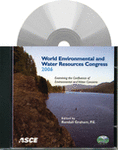Performance of Crop Coefficients Inferred from NDVI Observations for Estimating Evapotranspiration and Irrigation Scheduling of Wheat
Publication: World Environmental and Water Resource Congress 2006: Examining the Confluence of Environmental and Water Concerns
Abstract
Time-based crop coefficients are often used to estimate daily crop evapotranspiration (ETc) for determining irrigation scheduling. Incorporating remote sensing observations to infer crop coefficients during the season could provide the spatial and temporal estimation of ETc that is needed for precise irrigation scheduling. Experiments conducted for two seasons with wheat investigated the use of reflectance-based and time-based basal crop coefficients (Kcb), integrated within the FAO-56 dual crop coefficient framework to compute the daily ETc for determining irrigation scheduling. The experiments consisted of two main treatments denoted as the normalized difference vegetation index (NDVI) and the FAO treatments. Six, replicated sub-treatments, equally embedded within the two main treatments, included three plant densities (typical, dense, and sparse) and two nitrogen levels (high and low). NDVI data obtained from frequent ground-based canopy reflectance measurements were used to calculate the Kcb for each NDVI plot via a previously defined relationship mat describes Kcb as a function of scaled NDVI. A single time-based Kcb curve, developed locally for standard crop conditions, was used to estimate the daily Kcb for the FAO treatment plots. Predicted Kcb compared favorably with derived Kcb determined from field measurements for both the NDVI and FAO methods for standard conditions (typical density and high N) during the first season. However, the time-based FAO Kcb curve failed to adequately describe derived Kcb for any sub-treatment condition during the second season when crop development was atypical due to a late crop emergence date, delayed nitrogen applications, and a shorter growing season. Because the NDVI Kcb closely tracked derived Kcb for all sub-treatments, ETc prediction for NDVI was superior to FAO, particularly during the second season. In either season, the differences between the NDVI and FAO treatments for grain yield and water use efficiency (yield/ETc) were not statistically significant. However, compared to the standard FAO Kcb curve, the NDVI-Kcb method resulted in a significant decrease in the irrigation water used.
Get full access to this chapter
View all available purchase options and get full access to this chapter.
Information & Authors
Information
Published In
Copyright
© 2006 American Society of Civil Engineers.
History
Published online: Apr 26, 2012
ASCE Technical Topics:
- Agriculture
- Chemical compounds
- Chemical elements
- Chemicals
- Chemistry
- Climates
- Crops
- Curvature
- Ecosystems
- Engineering fundamentals
- Environmental engineering
- Evaporation
- Evapotranspiration
- Geometry
- Hydrologic engineering
- Irrigation
- Irrigation engineering
- Mathematics
- Measurement (by type)
- Nitrogen
- Seasonal variations
- Sensors and sensing
- Vegetation
- Water and water resources
Authors
Metrics & Citations
Metrics
Citations
Download citation
If you have the appropriate software installed, you can download article citation data to the citation manager of your choice. Simply select your manager software from the list below and click Download.
